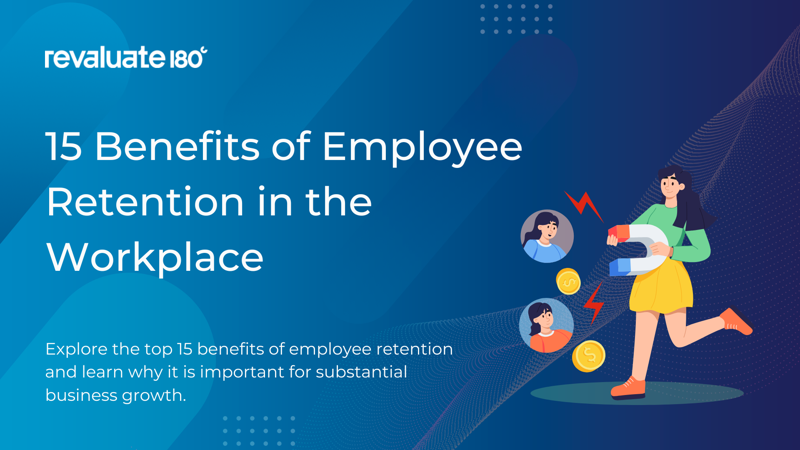Employee retention has become one of the most vital assets in today’s rapidly shifting organizations. Did you know that the cost of replacing an employee ranges from 50% to 250% of their annual salary? The financial impact of turnover is staggering, and organizations can no longer afford to treat retention as an afterthought; rather, it should be viewed as a significant competitive advantage.
In this guide, we’ll explore 15 strategic benefits of employee retention and understand why it is important for substantial business growth.
TL;DR
- Employee retention isn’t just an option anymore, but a strategic asset. Keeping your best talent leads to lower hiring and training costs, higher engagement, a stronger culture, better customer relationships, innovation, and improved DEI outcomes, which ultimately transform into higher profits.
- At the same time, turnover drains foundational knowledge, reduces productivity, and damages brand reputation. If you use proper data and statistics to identify and address the weakest links, you can prevent low retention rates.
- With solutions like Revaluate180’s data-driven insights and engagement tracking, organizations can spot retention risks early, tailor strategies, and build loyal, high-performing teams.
What is Employee Retention?
Employee retention refers to the ability to keep employees in the organization over time, especially when they’re high-performing and talented individuals who’re critical to operations.
It involves not only preventing unwanted turnover but also creating an environment where employees are willing to stay. Retention is distinctly different from reducing attrition since it’s all about building commitment, loyalty, and involvement.
In summary, retention encompasses everything from onboarding and career development to manager-employee relationships, culture, and growth opportunities, all of which are equally vital for organizational growth. These are the active conditions that make your top talent stay.
Why is Employee Retention Important?
Retention is crucial because the cost of turnover is high. Employee turnover doesn’t just cost in dollars; it costs in lost productivity, cultural damage, and missed growth opportunities that would’ve been the highest potential returns.
For example, one estimate suggests that replacing an employee can cost six to nine months’ salary from all aspects of recruiting, onboarding, and lost productivity.
Research shows that nearly two-thirds of turnover costs are intangible, including lost institutional knowledge, disrupted team dynamics, and decreased morale. Additionally, 66% of HR executives have identified employee retention as their top workforce challenge for 2025.
Companies with strong retention strategies are expected to be better positioned to build a great culture, deliver a consistent customer experience, and innovate to remain competitive for business growth.
What Are the Benefits of Employee Retention?

Let’s look into the top 15 strategic benefits of employee retention for business growth:
1. Lower Hiring and Recruitment Costs
When you retain employees, you don’t have to pay for the costly recruitment cycle that involves advertising positions, screening, interviewing, onboarding, and training replacements.
On the other hand, turnover costs can easily amount to one-third of an employee’s salary, not to mention the indirect costs that are also incurred. Moreover, with fewer employee exits, organizations can redirect resources to strategic innovations that are otherwise spent on constant hiring.
By reducing hiring and recruitment costs, companies can reinvest those savings to upskill their current employees by providing better tools and process improvements. This way, investment shifts from firefighting churn to building sustainable talent.
2. Higher Employee Morale
When employees see that turnover is low and people stay for various growth-related reasons, morale tends to improve, as there is stability, trust, and camaraderie, along with a shared sense of purpose. Conversely, frequent exits tend to create anxiety, feelings of abandonment, and an increased workload that gets increasingly worse every day.
This is crucial because recognition plays a key role in career growth and satisfaction. Organizations reporting high-quality recognition are 45% less likely to lose their employees after two years compared to those that don’t. A workplace that values its hardworking employees fosters long-term trust and reduces exit risk.
3. Improved Company Culture
Retention helps build a foundation of continuity, fostering shared values, institutional memory, and mutual norms. Employees who stay longer tend to thrive longer, becoming the culture that guides new hires and reinforces what is important, rather than allowing the culture to drift.
A strong culture helps attract and retain the best talent, where employee engagement remains among the top reasons for employees to leave or stay in the organization. As the culture improves, companies become more compelling places to work and collaborate, which in turn further reinforces employee retention.
4. Increased Productivity
The longer employees stay, the more proficient they become, as they understand business processes, know stakeholders, have built relationships, and can avoid the ramp-up time that new hires require. All of that adds to the output and reduces operational friction.
Furthermore, when teams retain their talent, they build seamless workflows where trust and tacit understanding become the most valuable assets. Each person contributes to accelerating the performance of those around them, thereby churning out all the strategic benefits beyond their tenure.
5. Retained Institutional Knowledge
The value of institutional memory can only be fully understood when employees stay long enough to establish a solid foundation. The mental models encompass how things work (both within and around), past decisions (both good and bad), customer histories, and lessons learned over the years. Losing such an employee means losing that repository of knowledge.
6. Improved Employee Engagement
Engaged employees are those who feel aligned and unified with the company’s mission, enjoy their work where they feel valued, and are most likely to stay for a long time because of these reasons. The modern workforce is productive when retention fosters engagement, and engagement fosters retention.
For instance, companies offering upskilling opportunities retain up to 58% more employees than those that don’t. By investing in career/financial development, recognition, and meaningful work, organizations not only keep employees but also enhance their motivation, creativity, and discretionary efforts.
7. Better Customer Relationships
Employees who stay longer tend to build deeper relations with customers and their teams. They understand their customers' requirements and psychological patterns, enabling them to provide each customer with a better experience.
On the flip side, high turnover often shows up as inconsistent service, longer resolution, and weaker relationships. That’s why retention directly supports customer loyalty, as employees are familiar with the history, context, and nuances of customer interactions and respond more quickly and effectively.
8. Stronger Brand Reputation
In 2025, job seekers scrutinize employer reputation, culture, and turnover rates almost as much as the salary. This is because companies with higher retention rates are often perceived as stable and desirable employers, expected to attract top talent.
Additionally, this retention signals to customers, partners, and stakeholders that the organization values its talent and that the company has a strong brand identity built on trust and equity. When employees stay and become ambassadors, they further amplify the brand’s external credibility.
9. Reduced Onboarding and Training Costs
Onboarding new employees and training them requires a significant amount of time and energy. The onboarding cost includes management time, shadowing costs, mistakes, and ramp-up loss that could’ve been redirected to solving bigger problems.
With high retention, organizations spend less on repeatedly onboarding new cohorts. With an experienced workforce, you can shift training budgets towards continuous development rather than just basic onboarding. Meaning you can invest in advancing employee skills, leadership development, and innovation that have the highest potential returns.
10. Increased Revenue and Profitability
Retention stems from consistent operations, reduced churn, increased productivity, deep customer relationships, and a strong culture that directly supports higher revenue and profitability. Studies draw direct links between turnover rates and product or service failures, faster time-to-market, and fewer errors. Over time, you’ll observe improved margins, increased customer lifetime value, and significant business growth.
11. Greater Innovation and Creativity
Tenured employees are more likely to feel psychologically secure and have the mental space to understand strategy and context, allowing them to form creative ideas and solutions to problems. They don’t spend all their time just learning the job; rather, they have the bandwidth to think and act on the spot.
Retention also means keeping those who might lead innovation efforts and contribute to solving various problems, rather than constantly replacing talent. When people see a future with your company, they’re more willing to take the initiative themselves and contribute beyond their pay grade. This is the ultimate key to fostering culture and innovation.
12. Competitive Advantage in Hiring
When you demonstrate strong retention, your organization becomes the center of attraction for all potential talent. This means you compete more efficiently and, more importantly, spend less on hiring top talent. The best candidates prefer workplaces where employees are willing to stay, are frequently recognized, and where growth is a foundational aspect.
While 51% of employees in the labor market are open to new job opportunities, organizations with good retention rates become more desirable. That’s how the recruitment process gets better, faster, and cost-effective.
13. Higher Employee Loyalty
Loyalty is the most valuable asset for the company, and retention is the best strategy to foster loyalty and trust. Employees who stay for a long time feel invested in the company, have deeper relationships, and understand the company culture better than those who are new.
Loyal employees often serve as brand ambassadors, becoming a valuable asset to the company, and do not seek validation from their team when it comes to taking efforts beyond their formal roles.
This is where loyalty becomes valuable, as it means a lower risk of an exit cascade. If a trusted colleague leaves, remaining loyal employees are likely to support the transition rather than seek other options. This creates stability that matters to the teams, culture, and most importantly, the customer.
14. Improved DEI Outcomes
Ineffective management, toxic employees, and a discriminatory hierarchy can become the most significant reasons to break a positive company culture. That’s where Diversity, Equity, and Inclusion (DEI) is crucial, as it works as a foundational morale for the workplace.
Since DEI policies eliminate negative traits, retention fosters an inclusive culture, supports career progression for all employees, and reduces the loss of diverse talent. Retaining diverse talent means you’re generating innovation, market understanding, and brand reputation that is yielded by employees who later become mentors and role models, strengthening the inclusive culture.
15. Reduced Burnout and Improved Well-being
Employee well-being is the key to productivity and high retention. Frequent turnover often places an unnecessary burden on remaining teams while risking increased burnout and low well-being. Therefore, retention for a reason signals stability, reduces chaos, and helps the team settle, which significantly contributes to their well-being.
Additionally, retaining talent helps in better investments, such as well-being programs and work-life balance initiatives, that are in great demand. A healthy workplace is more sustainable, productive, and engaging, so retention and well-being become a self-healing ecosystem.
What Causes Low Employee Retention?
Now that we know the benefits, understanding the root causes of low retention will help in addressing and fixing the problem proactively:
Lack of recognition, career growth, and unbiased compensation
One of the primary reasons employees leave is not only the lack of pay, but also a lack of recognition. When employees feel underappreciated, overlooked, or stuck, they tend to shift to where they are valued.
According to SHRM, the leading reason for 32% of employees leaving the company is a toxic or adverse work environment, which becomes their primary reason for disengagement.
This disengagement often leads to the exit. Ex-employees in a majority of exit interviews have said that the managers or the organization could’ve prevented their exit if they had acted upon the problem.
Poor management and a weak workplace culture
No, everyone is not born perfect, but we can always improve if we address our problems and act upon them. A bad manager or weak leadership significantly increases turnover risk. That’s why we always hear that employees leave bad managers, not bad jobs. If the work culture is inconsistent, undefined, or missing core values, retention is bound to suffer.
Good management and a strong workplace culture thrive under leadership that sets clear expectations, supports growth, and communicates openly. These are the qualities every employee looks for.
Limited flexibility and work-life balance
Flexibility is no longer an unfair advantage in 2025, but a fair expectation. Studies have consistently shown that flexible work arrangements increase retention by up to 25%. Rigid policies and unnecessary in-office days, or disregard for life outside work, tend to damage retention highly. When employees feel their personal well-being is not considered, they’re bound to look elsewhere.
Signs your retention strategy might be failing
If you think your retention is decreasing every day, these are the signs you may have to look for:
- A high proportion of early-stage exits. These are usually more than 30% within the first 6-12 months.
- Engagement or satisfaction scores decline while turnover rises.
- Constant onboarding costs while institutional knowledge continues to leak.
- Talent openly discussing leaving, or worse, planning a quit exit. If so, you’ll observe productivity decreasing dramatically.
How Revaluate180 Helps Improve Employee Retention
Our data-driven approach to employee retention enables organizations to transition from reactive fixes to proactive strategies, offering long-term and practical solutions. By tracking key indicators such as engagement, satisfaction, recognition, and effective management, we identify early signs to avert turnover risks.
Instead of relying on traditional annual surveys and check-ins, we deliver continuous, real-time engagement tracking through behavioral insights, pulse surveys, and manager check-ins. This offers organizations a live, bird's-eye view of employee sentiment, well-being, and loyalty, helping them craft compelling strategies.
By integrating data on satisfaction, burnout, recognition, and career mobility, Revaluate180 empowers HR leaders to design personalized retention strategies that are tailored to departments, roles, and individual employees. Get insights on your retention today and leverage all the strategic benefits discussed in this article.
Final Thoughts
Retention is no longer a “good-to-have”. It’s foundational to the organizational success in 2025 and beyond. By studying the benefits of employee retention, companies can move from reactive turnover fixes to proactive long-term solutions.
Our list of 15 benefits encompasses strategies that safeguard institutional knowledge, foster a strong work culture, and secure a competitive advantage in the modern workplace.

Unlock AI-Powered Hiring Analytics
Transform the way you hire with insights that create aligned, collaborative, and high-performing teams.
 Smarter Hiring Decisions
Smarter Hiring Decisions
 Reduce Expensive Turnover
Reduce Expensive Turnover
 AI-Driven Insights
AI-Driven Insights
 Optimize Team Performance
Optimize Team Performance

FAQs
1. Why is employee retention important in 2025?
Employee retention is necessary because more than half of all employees are open to leaving their companies. If organizations don't prioritize retention, they risk losing talent, incurring high costs, and falling behind in the competitive landscape.
2. What are the positive effects of employee retention?
Positive effects include lower hiring and training costs, higher morale, an improved culture, increased productivity, enhanced institutional knowledge, increased employee engagement, and overall deeper customer bonds.
3. What are the employee benefits for retention?
For employees, retention means stability, deeper bonds, stronger career development, better recognition, and improved well-being
4. How does retention impact business performance?
Retention has a significant impact on business performance through reduced costs of turnover, improved productivity, stronger customer support and experience, lower training and hiring costs, enhanced innovation, and a better brand identity that can resonate its core value back to the world.
5. What are the main causes of poor employee retention?
Lack of recognition, limited career growth, unfair compensation, toxic work culture, weak management, and lack of flexibility are just a few of the other factors that contribute to poor retention rates.
